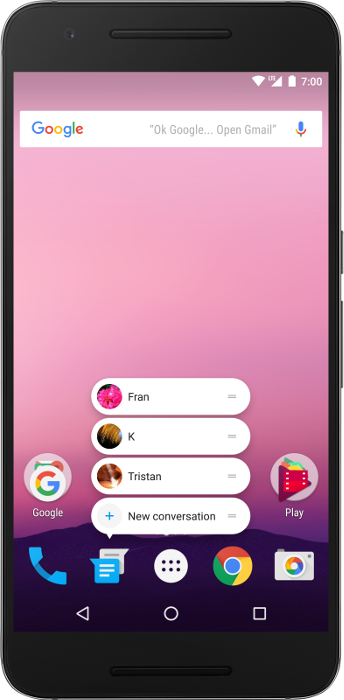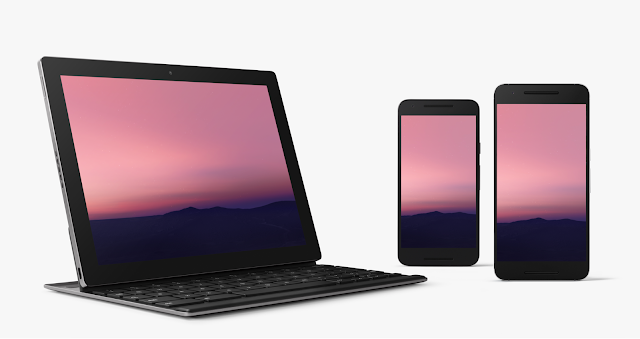Posted by Dave Burke, VP of Engineering
Today, we’re taking the wraps off of Android 7.1 Nougat, the latest version of the platform. You probably saw a sneak peek of it at last week’s event. It’s an incremental update based on Android 7.0 but includes new features for consumers and developers — from platform Daydream VR support and A/B system updates to app shortcuts and image keyboard support.
We’ve already been working closely with device makers to get them ready for Android 7.1, and next we’ll give you access to this update so you can start getting your apps ready.
Later this month we’ll be bringing you the Android 7.1 platform as an open Developer Preview, similar to what we did for Android 7.0. You’ll be able to test and build on the new platform and try the latest features.
As always, we’ll deliver the Developer Preview through the Android Beta program, which makes it incredibly easy to participate.
What’s in Android 7.1?
Android 7.1 delivers the productivity, security, and performance of Android 7.0, along with a variety of optimizations and bug fixes, features, and new APIs (API level 25).
For developers, Android 7.1 adds new capabilities to help you drive engagement in your app and deliver an improved user experience, such as:
- App shortcuts API — lets you surface key actions directly in the launcher and take your users deep into your app instantly. You can create up to 5 shortcuts, either statically or dynamically.
- Circular app icons support — lets you provide great-looking rounded icon resources that match the look of Pixel and other launchers.
- Enhanced live wallpaper metadata — lets you provide metadata about your live wallpapers to any picker displaying the wallpapers as a preview. You can show existing metadata such as label, description, and author, as well as a new context URL and title to link to more information.
Android 7.1 also adds these much-requested developer features to the platform:
- Image keyboard support — expands the types of content that users can enter from their keyboards, letting them express themselves through custom stickers, animated gifs, and more. Apps can tell the keyboard what types of content they accept, and keyboards can deliver all of the images and other content that they offer to the user. For broad compatibility, this API will also be available in the support library.
- Storage manager Intent — lets an app take the user directly to a new Settings screen to clear unused files and free up storage space on the device.
For carriers and calling apps, the platform includes new APIs to support multi-endpoint calling and new telephony configuration options.

Image keyboard support: Let users input images and other content directly from a keyboard.

App shortcuts: Use app shortcuts to surface key actions and take users deep into your app instantly.
Get your apps ready
Android 7.1 is an incremental release, but it’s always important to make sure your apps look and run great — especially as devices start to reach consumers.
The Android 7.1 Developer Preview will give you everything you need to test your apps or extend them with new features like shortcuts or keyboard images. Included are the SDK with new APIs, build tools, documentation and samples, as well as emulators and device system images for running your apps on supported Nexus devices. We’ll also include a launcher and apps that support app shortcuts, and a keyboard and apps that support keyboard images.
If you want to receive the Developer Preview automatically, visit Android Beta and enroll your device. If you previously enrolled a device and haven’t unenrolled, your device will receive the update. If you already enrolled but don’t want to receive the update, visit Android Beta to unenroll the device as soon as possible.
Initially, we’ll offer the Developer Preview for Nexus 5X, Nexus 6P, and Pixel C devices, extending to other supported devices by the end of the preview. At the final release of the Android 7.1.x platform, due in early December, we’ll roll out updates to the full lineup of supported devices — Nexus 6, 5X, 6P, 9, Player, Pixel C, and supported Android One devices — as well as Pixel and Pixel XL devices.
Coming to consumer devices soon
We’re working with our partners to bring Android 7.1 to devices in the ecosystem over the months ahead, so we recommend downloading the Android 7.1 Developer Preview as soon as it’s available. Test your apps for compatibility and optimize them to look their best, such as by providing circular app icons and adding app shortcuts.
Meanwhile, stay tuned, we’ll be sharing more details about the Developer Preview soon!













